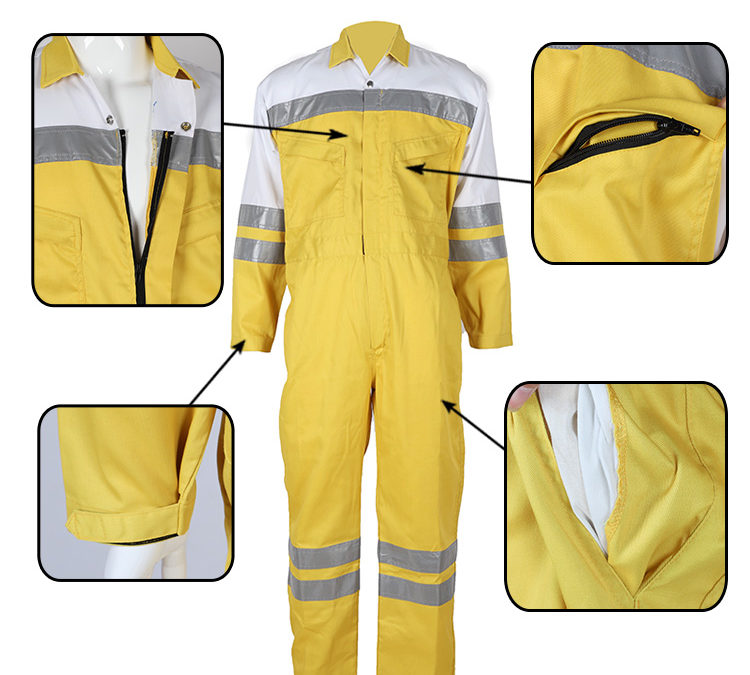

How to identify the quality of workwear fire retardant?
How to distinguish the quality of a workwear flame resistant is mainly the following five points;
First, the appearance is. The product is neat, flat, folded and right, symmetrical, all parts are ironed flat, no leakage, no dead pleats, product wireless head, no yarn, all parts meet the standard requirements. The line is compatible with the fabric, including color, texture, fastness, shrinkage, etc., and the two should be roughly the same to ensure the intrinsic quality and appearance quality of the reflective coverall. The color of the button should match the color of the fabric.
Second, the size of the second workwear fire retardant. Each work reflective coverall model is different, and the models of each country are different. According to the different needs of customers, it must be carried out according to the relevant regulations of the “clothing type series” standard. Specifications are limited to the tolerances allowed by the standard.
Third, the color difference of workwear flame resistant. The color difference rule is the requirement for raw materials, that is, the requirements for the fabric of the overalls. According to the national standards for the color difference, the upper collar of the garment, the fabric of the bag, and the side seam of the trousers are the main parts, the color difference is higher than the fourth grade, and the other surface parts are four grades. The color difference test of the flame resistant overalls, the tool is to borrow the "dye fastness fading sample card". The sample card is one of the national standards established by the former Ministry of Textile Industry. The sample card consists of five pairs of gray standards and is divided into five levels. The fifth-level representative has the best fade fastness, the color difference is equal to zero, and the fourth-level to the first-level represents the relative increase in fading, and the first-level indicates the most serious.
Fourth, there are also tips for work flame resistant clothes. The standard stipulates that only one point is allowed for each individual part. The independent part is the area divided by the piece, and the main part of the piece is divided into four areas of 1, 2, 3, and 4. Each part is an area on the piece of clothing. The upper garment has two front panels, each of which has a 1 part, each part is an independent part, and the two parts are two separate parts. In this separate part of the chest, there are both a piece of flame resistant clothing and a patch pocket and a flap. The standard stipulates that each individual part is allowed to have only one defect, that is, there is a defect on the piece of clothing, and there is no possibility of any defects on the patch pocket and the bag cover in this independent part. The type of defects varies with different fr fabrics. The judgment shall be carried out in accordance with the standard regulations.
Fifth, the last is the sewing of the flame resistant overalls. The stitch length of the bright line (including the dark line without the open line) is specified in the stitch pitch density, 14-18 stitches per 3 cm. There are many varieties of fabrics. To ensure the appearance and firmness of the products, different fabrics should be selected with different stitch lengths. For example, the stitch length of a hard fabric can be thinner, and the fabric with a soft texture can generally be denser. Straight line means that the lines of the sewing parts are not allowed to bend randomly, and must meet the needs of the overall shape of the overalls; the lines should be neat, do not overlap, no jump stitches, throwing lines, clear stitches, and the starting and stopping stitches of the sewing Firm, the length of the head line should be suitable, no needle leakage, off-line phenomenon, the stitch tightness should be compatible with the thickness and texture of the fr fabric. The symmetrical parts in the sewing quality of the reflective coverall are basically the same. In addition to looking at the stitches, the inspection of the sewing quality of the garments should also be seen in the splicing and clamping. The splicing mainly depends on whether the splicing of the waistband and the lower jaw is reasonable, and then whether the splicing of the interior such as the noodle and the collar meets the requirements. For flame resistant clothes with clips, check the length and fatness of the clips, and whether the inside is flat. If all the above five points meet the requirements, indicating that the quality of the flame resistant work clothes is qualified, Xinke Protection Technology Co., Ltd. has always insisted on using the first-class technology to tailor the most suitable work clothes for customers, and to satisfy the public with first-class services.

